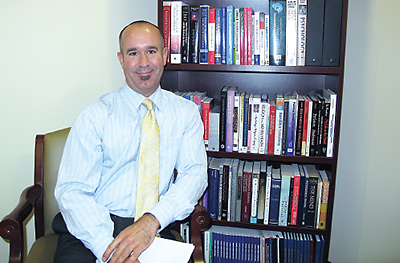Future Looks Promising for Mental Illness Prevention
Abstract
Research over the last decade shows that depression and anxiety are preventable, and psychiatrists are optimistic that advances in averting these and other mental illnesses are on the horizon.
Since effective treatments for mental illnesses emerged only during the 20th century, it is probably not surprising that scientifically based mental illness prevention is only now coming of age, stated George Alexopoulos, M.D., director of the Weill-Cornell Institute of Geriatric Psychiatry, in a recent interview.
Indeed, “there has been a huge explosion of work in mental illness prevention during the past decade,” Carol Koplan, M.D., told Psychiatric News. She is a child and adolescent psychiatrist and assistant adjunct professor in health policy at Emory University, where she teaches a class in prevention of mental disorders to students in the master’s-degree program in public health.

Charles Reynolds, M.D.: “We plan to work with colleagues in India to determine whether the depression intervention strategies we’re testing in North America can be implemented and taken to scale by lay health counselors in a low- and middle-income country, namely India.”
“There are probably 20 or 30 good randomized clinical trials indicating that the onset of common mental disorders like depression and anxiety can be delayed and in some cases prevented,” Charles Reynolds, M.D., a professor of geriatric psychiatry at the University of Pittsburgh, said. For instance, cognitive-behavioral therapy and interpersonal therapy have been found to be effective in reducing the incidence of major depressive episodes in people who have already had mild or subsyndromal depressive symptoms. A Dutch study found a 50 percent reduction in the incidence of major depression among mildly depressed primary care patients who received a stepped-care intervention, compared with the incidence among primary care patients who received treatment as usual. Other studies showed that low-dose antidepressants or problem-solving therapy helped reduce the incidence of major and minor depression in post-stroke patients.
“A number of clinical trials,” Reynolds noted, “have also supported a role for lithium in suicide prevention in people living with bipolar disorder and for clozapine for people living with schizophrenia. In addition, we performed the PROSPECT study—the Prevention of Suicide in Primary Care Elderly: Collaborative Trial study—which showed that the implementation of evidence-based depression-care guidelines in primary care practices could reduce the prevalence of suicidal ideation.”

Michael Compton, M.D., M.P.H., advises psychiatrists to promote mental health by taking part in programs that focus on preventing delinquency, bullying, unwanted teen pregnancies, child abuse, or violence in schools.
In the opinion of Michael Compton, M.D., M.P.H., a professor of psychiatry at George Washington University and a preventive medicine specialist, two recent mental illness prevention studies deserve special notice. “In 2009, Garber and colleagues published a study in JAMA showing that a group-based cognitive-behavioral program reduced the rate of depressive episodes in adolescent offspring of depressed parents,” he said. “In 2010, Amminger and coworkers published a study in the Archives of General Psychiatry showing that omega-3 fatty acids, or fish oils, reduced the risk of transition to psychosis among young people deemed to be at very high risk for a psychotic disorder.”
One of the most impressive mental illness prevention studies conducted to date, Koplan suggested, was designed by David Olds, Ph.D., director of the Prevention Research Center for Family and Child Health at the University of Colorado. Nurses visited high-risk mothers from lower socioeconomic backgrounds during pregnancy and for two years after to help them give their children a good start in life. Olds and his colleagues then followed the children and their mothers for several years to see whether the intervention made a difference in mental and behavioral health outcomes. It did. For example, the mothers experienced fewer arrests and convictions, engaged in less child abuse and neglect, and abused substances less than did control mothers. By 2008, Olds’ program, which was called the Nurse-Family Partnership, was operating in 24 states (Psychiatric News, August 1, 2008). By July 2012, it was operating in 41 states, according to the Nurse-Family Partnership Web site.
Another prominent advance in mental illness prevention, Koplan pointed out, is the Interactive Screening Program (ISP) of the American Foundation for Suicide Prevention (AFSP). The ISP is an anonymous, interactive Web-based method of reaching out to students at risk of suicide. It has been shown to be effective in getting these students into treatment. The ISP is now being used in more than 40 colleges and universities in the United States, according to the AFSP Web site.
“There has also been very good research on drug- and alcohol-abuse prevention,” said Christopher Oleskey, M.D., M.P.H., an assistant professor of psychiatry at Yale University.
Evidence Makes Conclusions Difficult
The scientific evidence for the prevention of certain disorders, however, is stronger than it is for others. For instance, the evidence for preventing schizophrenia is considerably skimpier than that for preventing depression, Frederick Langheim, M.D., Ph.D., a staff psychiatrist at Dean Health Systems in Madison, Wis., observed. The same holds true for bipolar disorder prevention, Oleskey indicated.
And the evidence may be stronger for secondary prevention—that is, for preventing recurrent episodes of an illness—than for primary prevention. For example, there is more robust scientific evidence on how to prevent additional episodes of unipolar depression and bipolar depression than for preventing them in the first place, Alexopoulos said.
But much more will undoubtedly be learned about mental illness prevention during the next few years because, as Koplan said, “it’s a tremendously growing field. Within psychiatry it is becoming clearer that prevention is important, and in public health, people are starting to realize how common mental illnesses are.” The field, she added, will also benefit from increased dissemination of mental illness prevention interventions that are found to be effective. Indeed, the Substance Abuse and Mental Health Services Administration is already attempting to disperse evidence-based interventions for preventing mental illness through the National Registry of Evidence-Based Practices and Programs, she pointed out.
Prevention Studies in the Works
So what findings in mental health prevention might be emerging during the next few years?
Reynolds and his colleagues are studying whether problem-solving therapy, behavioral treatment for insomnia, and walking can prevent full-fledged depression in people who are mildly depressed. They are also looking to see whether cytokine levels in the bloodstream might be used as a biomarker for depression risk and to determine if a depression prevention intervention is working.
“Some of my research pertains to factors driving treatment delay . . . in young people with first-episode psychosis,” Compton said. “We are finding that a number of factors contribute to this variable period of treatment delay. . . . Understanding the factors that contribute to delayed help-seeking may benefit programs focusing on early intervention for psychotic disorders.”
“I think we are going to learn that we can prevent mental illnesses in ways that we haven’t thought of at this time,” Oleskey predicted. ■
Information about mental illness prevention can be found in "The Clinical Manual of Prevention in Mental Health", published by American Psychiatric Publishing. APA members can purchase the book at a discount at http://www.appi.org/SearchCenter/Pages/SearchDetail.aspx?ItemID=62347.
Several psychiatrists with an interest in mental illness prevention offer suggestions on how their colleagues might apply some of the latest research findings in this field.
A mental health prevention application that can be downloaded onto doctors’ iPhones has been designed by the Agency for Healthcare Research and Quality, Christopher Oleskey, M.D., M.P.H., an assistant professor of psychiatry at Yale University, reported. It is called the Electronic Preventive Services Selector (EPSS). The way it works, he explained, is that you type in a patient’s demographic information, and the EPSS then gives you evidence-based screening tools to use with the patient—tools to help detect early warning signs of a mental disorder. The EPSS can be accessed at http://epss.ahrq.gov/PDA/index.jsp.
One way to help patients avert mental illness is to encourage lifestyle habits that promote mental health, such as eating a healthy diet, getting enough sleep and exercise, and avoiding substances, Frederick Langheim, M.D., Ph.D., a staff psychiatrist at Dean Health Systems in Madison, Wis., suggested. With bipolar disorder, for example, there is evidence that avoiding the use of marijuana and getting enough sleep can help prevent the resurgence of episodes, he said. | |||||
A previous suicide attempt, recent discharge from the hospital after a suicide attempt, family history of depression, or a gun in the house can alert psychiatrists to patients who might be in danger of a suicide attempt, Carol Koplan, M.D., an assistant adjunct professor of health policy at Emory University, said. And whenever psychiatrists see patients, they should try to be prevention-minded, she suggested. For instance, a patient being treated for depression should be regularly evaluated for comorbidities such as substance abuse during times of crisis. | |||||
Psychiatrists should take part in programs focusing on prevention of delinquency, bullying, unwanted teen pregnancies, child abuse, or violence in schools, Michael Compton, M.D., M.P.H., a professor of psychiatry at George Washington University, proposed, because such collaboration “will undoubtedly promote mental health and reduce mental illness. | |||||



